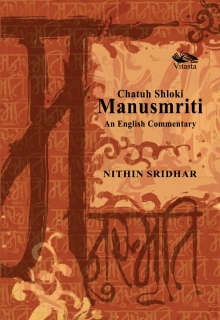The Manusmriti is a much-misunderstood text today.
Though historically, both Manusmriti and the originator of its teachings – Svayambhuva Manu, were both held in high esteem as the foremost authority on Dharma by not only the scholars of Dharmashastra tradition, but also by great philosophers and spiritual giants belonging to different Sampradayas. From Vyasa to Kumarila Bhatta to Adi Shankaracharya, all have cited Manusmriti as an authoritative source on Dharma.
Nevertheless, as things stand today, Manusmriti has been reduced to a punching bag on which every ill of contemporary society, real or imagined, can be heaped upon. The text has experienced burning, abuse, prejudice, and misrepresentation. But most of all, misunderstanding.
There is perhaps no other text in contemporary India which has been as misunderstood as Manusmriti and other similar Dharmashastra texts. From Manu's treatment of caste to its treatment of women, everything has been problematized and positioned as a source of evil, all the while not even engaging the text with an ounce of sincerity, thirst for knowledge, and an openness of the mind and the heart.
Manusmriti can be counted among those works which are very oriented towards women and addresses many of the concerns of women including their safety and wellbeing. However, contemporary scholarship owing to preconceived bias have misunderstood and misrepresented the text as anti-women! Similar lacunae can be pointed out in other areas of contemporary criticism as well.
The contemporary society's ignorance, prejudice, and discomfort with Dharmashastra tradition in general and with texts such as Manusmriti in particular owes much to the effects of colonialism and the destruction of indigenous education institutions, as a result of which the society has become deracinated having lost touch with this core aspect of our culture.
In particular, people find it exceptionally difficult to relate to the teachings of the Manusmriti owing to unfamiliarity with the purpose, textual landscape, and the underlying worldview. Furthermore, the Manusmriti and other Dharmashastra texts employ a unique language to convey its teachings about dharma which poses significant challenges to understand and appreciate it owing to presentism.
My book 'Chatuh Sloki Manusmriti: An English Commentary' seeks to fill this gap in contemporary approach and facilitate a better understanding of Manusmriti through a philosophical study of the first four verses of Manusmriti which clarifies the object, purpose and relevance of dharma texts. Rather than reducing Manusmriti through a historicist study into a relic of the past which merely serve as a document of past events, the book locates the text in its larger Hindu epistemological, ontological, and theological worldview and extracts the eternal teachings embedded within it.
The book further clarifies some of the common misconceptions, especially those related to fundamental questions such as definition of dharma, integrity and importance of Manusmriti, the notion of ritual competency, Hindu conception of varṇa, etcetera and introduces the Dharmashastra landscape to a lay reader so as to facilitate a meaningful engagement with these texts.
Book : Chatuh Shloki Manusmriti: An English Commentary
ISBN : ISBN: 9788119670918
- Nithin Sridhar
